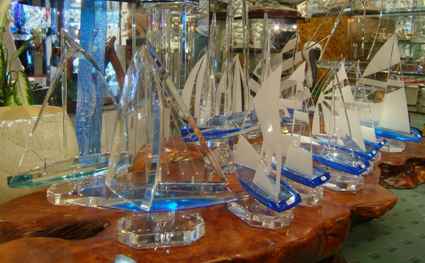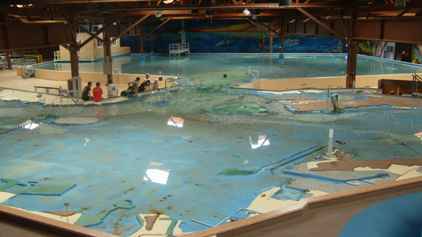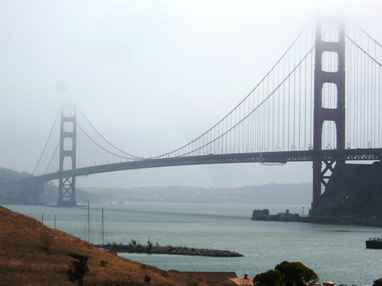| So the next day we went over the bridge to the town of Sausalito.
This is really quite an arty outpost of the conurbation. San Francisco is
not really that big but it merges with several other major cities such as
Oakland which together make up what is generally thought of as San
Francisco. |
 |
 | One of the wine
bars on the sea front had a collection of art work upstairs. Generally I
find little which excites me but there were several still life paintings
here which I quite liked. Not enough to buy of course. |
| Perhaps it is that I also enjoy the wines so the paintings had
some meaning for me. Mind you this is California and most of the wine is
made in climate controlled stainless steel vats rather than these oak
barrels which are more reminiscent of France. |  |
 | We also found
many shops selling ceramics and glass items including this collection of
acrylic boats. We did find another shop with clear acrylic boats which I
thought were better. |
| Some of the ceramic vases were pretty impressive but at $650 we
didn't feel we could have kept it safe until we got home. Generally I find
little in these type of places but this town seemed to have better quality
than the usual collection of tat. |  |
 | I did spot a
couple of camels in the window of an art exhibition. They were very pretty
but it was the sort of place I don't even consider going in. These would
have been a one-off item by an artist of renown at a commensurate price.... |
| Sometimes the oddest things take your fancy and can lead to quite
remarkable finds. One such find was the "Bay Model". This is a concrete
scale model of the waterways of the Bay in a building covering 3 acres. It
was built in 1957 and was used by the US Army Corps of Engineers to test the
impact of proposed changes to the Bay and associated waterways. There is a
huge tank which represents the ocean, and pumps simulate the daily tides
every 15 minutes. |  |
 | The model covers
all three main bays although one has been angled at 43°
to enable it to fit in the building. It also covers a large proportion of
the irrigation systems in the basin. Part of the system uses salt
water and part uses fresh water because they have different densities. The
model has over a quarter of a million copper tabs which help to model the
currents. It was in use as a scientific tool to simulate the impacts of
pollution, salt water intrusion, barrier and fill studies until 2000 when it
was retired in favour of computer models. Today it is used as an educational
tool and was absolutely fascinating. |
| We did at last get to see the famous Golden Gate Bridge. You
could actually see the water flowing backwards and forwards under the bridge
as the tides cycled under constant computer control. The horizontal scale is
1:1000, vertical is 1:100 and velocity is 1:10 |  |
 | Outside was one
of the dredgers which fight the constant battle to keep some of the channels
open. Inside were models of all the different types of dredgers used by the
authority. |
| If there had not been so much mist you would have been able to
see the complete skyline of San Francisco. This shot is the result of
significant computer enhancement. This wasn't what you could see with the
naked eye |  |
 | Going back we had
another go at photographing the Golden Gate Bridge. This was a little more
successful but not perfect. I wonder how long these photographers wait for
their perfect shots. |
|